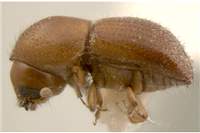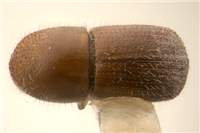Diagnosis
Theoborus is recognized by the antennal club with two sutures visible on posterior face and by the smooth and flat posterior face of the protibia. Often similar to Coptoborus spp., but more robust, and with rounded elytral apex, not emarginate as in many Coptoborus.
Distribution
Mexico to South America, one species introduced into Africa.
Biology
Xylomycetophagous.
Taxonomy
Possibly intergrading with or nested within Coptoborus, but rarely studied.
Detailed description
Eyes shallowly emarginated, upper portion of eyes smaller than the lower part. Antennal club approximately circular, club type four not truncated, first segment anteriad smaller than second, both convex. Segment 1 of club circular around the club, concave frontally, covering most of the posterior face, its margin soft, pubescent. Segment 2 of club visible on both sides of club, but not circular (not making antenna tall, or telescopic). Segment 3 of club clearly visible on both sides of club. Segment 1 shorter than pedicel, funicle 4-segmented. Scapus regularly thick. Frons above epistoma mostly smooth, alutaceous, with minor punctures or rugged and coarsely punctate. Submentum flat, flush with genae, shaped as a narrow triangle. Anterior edge of pronotum with no conspicuous row of serrations (serrations dont differ from those on the pronotal slope. Pronotum from lateral view basic type (type 0) or dorsal side uniformly rounded, no clear summit (type 1). From dorsal view subquadrate, anterolateral corners slightly prominent (type 3). Pronotal disc shining or smoothly alutaceous, with small punctures, lateral edge of pronotum obliquely costate. Procoxae contiguous, prosternal posterocoxal process tall and pointed. Tuft on pronotal basis associated with mesonotal mycangium absent, setae on elytral bases associated with elytral mycangium also absent. Scutellum flat, flush with elytra. Elytral bases straight, with oblique edge, elytral disc longer than declivity, and convex or bulging, punctures on elytral disc in strial lines (which may be difficult to discern). Boundary between elytral disc and declivity distinct or indistinct, disc rounded, smoothly transitioning into declivity. Lateral profile of elytral declivity slowly descending, often flat, dorsal profile of elytral apex rounded, convex apically and not broadened laterally or prolonged apically, attenuated or angulate. Elytral declivity few setae or scales, not conspicuously pubescent. Posterolateral declivital costa elevated with the carina short and inconspicuous. Surface of declivity devoid of tubercles. First interstriae parallel (sometimes slightly broadened towards elytral summit). Striae and interstria on the upper part of declivity even, flush with the surface. Protibia obliquely triangular, broadest in 2/3 of the length. Posterior side of protibia flat, with setae only. Protibial denticles small, bases of denticles not enlarged, protibial margin rounded, 6 8 protibial denticles present. Metatibia of normal size. Color uniformly light brown or reddish (pronotum sometimes slightly lighter). Length: 1.7 3.0 mm.


